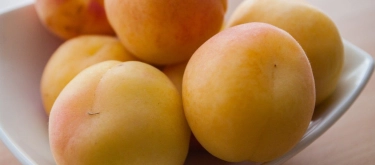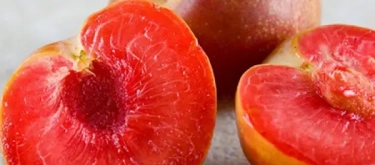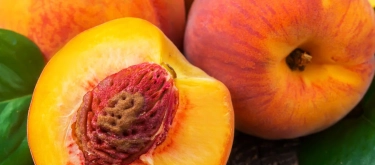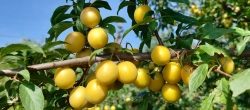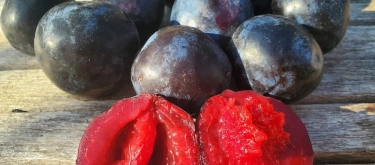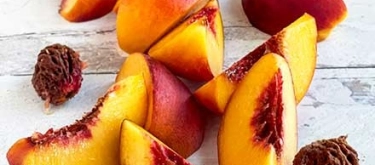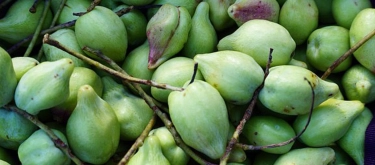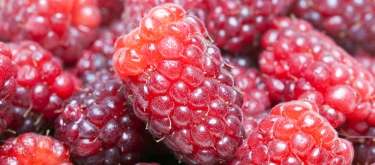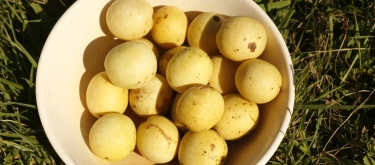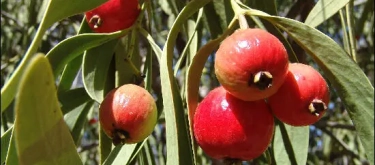Sharafuga: Taste Profile, Aroma, Benefits and Health Risks
Sharafuga is an innovative hybrid stone fruit, uniquely bred from apricot, plum, and peach. Developed to combine the best sensory attributes of each parent fruit, sharafuga has a complex and intriguing flavor profile. Originally developed through advanced breeding techniques in the United States, this specialty fruit is sought after by gourmet enthusiasts for its unique combination of sweetness, tanginess, and aromatic complexity.
Sharafuga, as a hybrid stone fruit, may trigger allergic reactions in individuals sensitive to peaches, plums, apricots, cherries, or almonds. Its pits contain cyanogenic glycosides and must never be consumed. Pregnant women can safely consume moderate quantities.
What does Sharafuga taste like?
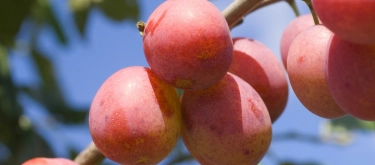
Complete Sensory Description:
Taste
Sharafuga offers a rich, complex flavor that harmoniously blends sweet, tart, and mildly floral notes. Initially sweet and fruity like peach and apricot, its flavor progresses into gentle tartness reminiscent of plum, accompanied by subtle almond-like undertones.
Aroma
The aroma of sharafuga is distinctly fruity and delicately floral, featuring dominant peach and apricot fragrances with subtle plum and almond blossom accents, providing sophisticated depth.
Texture
Sharafuga’s texture combines qualities of its parent fruits, featuring smooth, moderately firm skin that encases tender, juicy, and succulent flesh. The pulp is less fibrous than peaches, softer and juicier than apricots, and somewhat firmer than plums, creating an invitingly balanced mouthfeel.
Appearance
Sharafuga fruits are medium-sized, typically 5–8 cm in diameter, round to slightly oval. The skin color ranges from deep purple-red or burgundy to yellow-orange blushes, resembling plums or nectarines externally. Inside, the flesh typically exhibits vibrant shades ranging from golden-yellow to reddish tones around a central stone.
In-depth Flavor Analysis:
Sharafuga’s unique taste arises from an intricate interplay of sugars, acids, tannins, and volatile aromatic compounds inherited from its complex genetic lineage:
-
Sweetness Profile: Sharafuga is notably sweet due to its balanced fructose and sucrose content, inherited primarily from apricot and peach parentage, presenting lush sweetness with distinct honey-like tones.
-
Acidic Balance: Moderate amounts of malic and citric acids, primarily inherited from plum parentage, introduce gentle tartness, providing essential balance to sweetness. This acidity accentuates the fruit’s refreshing qualities, preventing cloying sweetness.
-
Aromatic Complexity: Aromatic volatiles include gamma-decalactone and benzyl acetate, contributing distinctly peachy and apricot-like aromas. Ethyl butanoate imparts fruity sweetness, while subtle almond-like notes from benzaldehyde enrich complexity. Low levels of floral terpenes such as geraniol and linalool add additional nuance.
-
Environmental Influence: Flavor characteristics vary significantly depending on climate, soil conditions, and harvest timing. Optimal sweetness and aromatic complexity are achieved under warm, sunny climates with proper water management and timely harvesting.
Varieties and Culinary Applications:
Currently, sharafuga is available primarily as a single hybrid variety, with minor regional differences in flavor intensity and coloration. Culinary uses include:
- Fresh Consumption: Ideal for eating fresh, providing a juicy, flavorful snack or dessert.
- Desserts and Baking: Excellent in pies, cobblers, pastries, cakes, tarts, and fruit crisps, enhancing sweetness and aromatic complexity.
- Preserves: Commonly used in jams, marmalades, sauces, compotes, chutneys, and syrups due to vibrant color and balanced flavor.
- Beverages: Frequently added to smoothies, juices, fruit cocktails, and refreshing beverages, adding unique aromatic notes.
Selection and Storage:
Choose sharafuga fruits with vibrant, unblemished skin, yielding gently to slight pressure. Avoid overly firm, bruised, or visibly damaged fruits. Store ripe sharafugas refrigerated for up to one week, consuming promptly after ripening at room temperature. Fruit flesh can be frozen effectively after pitting for later culinary use.
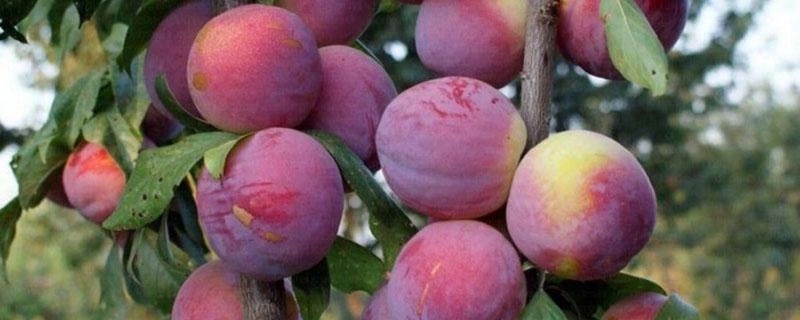
Nutritional Insights:
Sharafuga offers a valuable nutritional profile, rich in vitamins A and C, dietary fiber, potassium, antioxidants, and beneficial phytochemicals. Regular consumption supports immune health, enhances digestion, promotes skin health and vision (due to vitamin A), and reduces inflammation through antioxidant properties. Potassium content assists in blood pressure management, making sharafuga beneficial for individuals at risk of hypertension or cardiovascular concerns.
Expert Insights & Culinary Tips:
- Flavor Pairings: Sharafuga pairs perfectly with aromatic spices such as cinnamon, ginger, vanilla, nutmeg, and cardamom. It complements dairy-based foods like yogurt, ice cream, ricotta, and mascarpone exceptionally well.
- Preparation Recommendations: Allow sharafuga fruits to ripen fully at room temperature for optimal sweetness and aroma. Light cooking (grilling, roasting, or poaching) can further develop complex flavors, caramelizing sugars and softening acidity.
- Pit Safety: Always remove and discard sharafuga pits due to their cyanogenic content.
Interesting and Curious Facts:
- Sharafuga’s creation is a recent achievement in hybrid stone-fruit breeding, combining three fruits (plum, apricot, and peach) to yield a uniquely flavored and textured fruit.
- Its name, "sharafuga," cleverly blends syllables from parent fruits, underscoring its hybrid identity.
- Due to its unique heritage and limited commercial availability, sharafuga is predominantly featured in specialty markets, gourmet restaurants, and among fruit enthusiasts.
Harm and Dietary Considerations:
Sharafuga is safe for moderate consumption, yet allergic reactions may occur in individuals sensitive to related stone fruits (peaches, plums, apricots, cherries, almonds). Pits contain cyanogenic substances, which are toxic and must not be ingested. Moderate consumption during pregnancy and breastfeeding is considered safe.
Religious Dietary Considerations:
Sharafuga is universally acceptable without restrictions across all major religious dietary guidelines, including Halal, Kosher, Hindu vegetarianism, and Buddhist dietary practices.
Final Thoughts & Sensory Journey:
Sharafuga offers an extraordinary sensory journey, blending peach’s luxurious sweetness, apricot’s delicate fragrance, and plum’s refreshing tartness into one sophisticated, juicy fruit. Its nutritional richness and culinary versatility further enhance its appeal, making sharafuga a compelling choice for fruit aficionados.
Resources:
- "Temperate and Subtropical Fruit Production" by David Jackson and Norman Looney (CABI, 2011)
- "Fruit Breeding" edited by Maria Luisa Badenes and David H. Byrne (Springer, 2012)
- "Handbook of Fruit and Vegetable Flavors" by Y.H. Hui (John Wiley & Sons, 2010)
